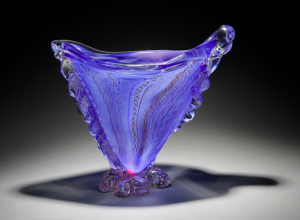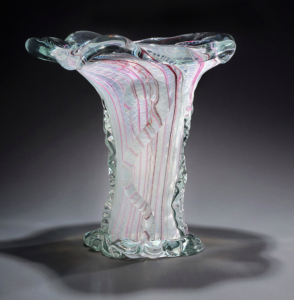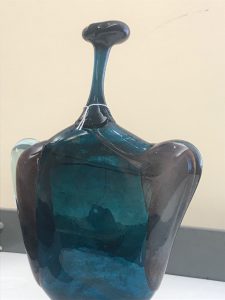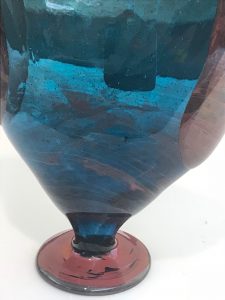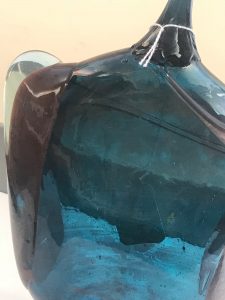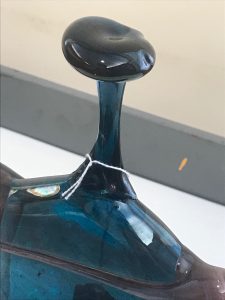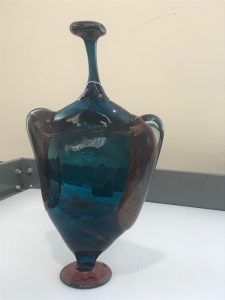Fritz Dreisbach’s piece “Non-Bottle” is one in a conglomeration of his works that plays with the viscosity of glass. Dreisbach has stated, “…One of my favorite, unique properties of glass is the constant change in viscosity due to variations of temperature.” This can clearly be seen in his other artwork such as the “Mongos” pictured below. These pieces are some in a cast series attempted to play with the dimensions of glass that can be produced. The weight of these bases are integral in the support of the large protruding tops. A common theme in the visual patterns seen across Dreisbach’s work includes vivid colors, with interlaid accent colors. In M-10 and M-17 this is seen in the diamond cross hairs, and long vertical lines. However, in Dreisbach’s piece, Non-Bottle, viewers do not see these exact, hard set lines, but rather flowing colors, and speckles of reflective color.
Upon first observation of M-10, M-17 and Non-Bottle, I believed Dreisbach had laid his chosen glass in to a kiln, and achieved his forms over by draping the glass over preformed molds. This would explain the way the glass looks as if it was draped when it was molten, as well as the way in which the other glass colors had been inlaid into the base. Below I have attached an educational video that explains this way of glass molding.
However, it soon became apparent within Non-Bottle, that the object was most likely blown glass, for at least the center piece. Given that the Non-Bottle does have air within, and is then sealed off more like an urn, it would be impossible to kiln fire the piece. This dispelled my hypothesis given that glass blowing would form the urn shape in a much better form then if it were kiln fired. I believe Dreisbach had a large quantity of molten glass, and blew the thorax in one continuous piece.
Afterwards the base, shown in Figure 4, was added using a lighter colored glass. The side and top appendages were most likely added in a similar fashion later. As seen near the base in Figure 4, the side pieces have a visible projection in comparison to the thorax. The glass of both the sides and the middle must have been heated to molten levels before they could have been attached. As well, in Figure 3, you can see a long small stripe of glass that heads upwards towards the cap which seals off the middle. This was most likely the way in which the artist tapered off the extra glass, similar to the way we pulled the heated glass and created skinny spindles.
The differences in color between the blue thorax and the purple base along with the purple on the sides is striking. However, I hypothesis that the purple we view is not actually purple glass, but rather the reaction of the blue with the clear glass seen on the edge of the sides. This is proven with the purple streak seen across the thorax of the vase. Also one of the details of the piece located at the bottom of the figure, near the base in Figure 4, is the slight gradation of the color. This is formed when two different colored glasses are mixed together, similar to mixing paints. The process resembles mixing paints, quantities of both colors of glass are mixed, in this case blue and indigo, and then heated until the glass turns viscous. These imperfections are created when the medium is not dispersed perfectly together, but the result is similar in appearance to an oil spill of vibrant colors.
The cap on the top of this piece was very interesting. Other than the obvious completely closed off top, mitigating the original purpose of a bottle or vase, the small dimple at the top is telling in the way in which it was probably attached to the bottle. The dimple appears as if it was formed by the flow of the glass downwards. This would be characteristic of Dreisbach’s fascination with viscosity, and how he lets the glass flow to form what ever it will. I believe the glass for the top was probably a-fixed to thorax and then the glass was pulled upwards, creating the slender throat of the vase, as well as forming the small dimple at the apex of the figure.
Part of the wonder of this piece, is its ability to defy gravity. While the piece does not appear to be overly heavy, it does have the two protruding arms attached to its sides that look substantial in comparison to the thorax. Dreisbach’s work often “…strive[s] for a balance between control and spontaneity” and this piece exemplifies that. There is no part of the vase that looks completely as viewers would expect, rather it looks as if it was left in a hot car for too long and has warped. I believe this was purposefully done by Dreisbach, as it consistently reminds viewers about the innate viscosity and movement of glass. Simply looking at the piece I have rethought the constraints and barriers of glass as a material, and my eye is drawn to the ability of glass to flow and be warp-able. The viscosity of glass can be captured even when it is completely cooled, but the Non-Bottle reminds viewers of the whimsy and versatility of glass as well as it’s strength even when draped in odd shapes.
